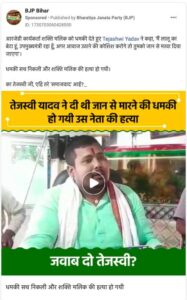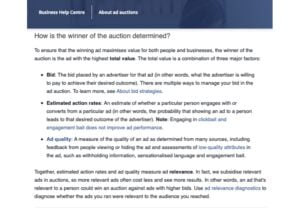India da, BJP na hanna Facebook ki early bird oirubanina, party si Facebook ta peisa atoppa party dei henna thadei. BJP gi affiliates, associates amadi proxies singna yaam mangjin thakhrae social media platform sijinabasi.
*KHANG-HANJABA: Masi gi report asi The Reporters’ Collective ki investigative report Part 4 (aroiba) ni. Originally English ta Part mari thokna publish toubani, TFM na Meeteilon da handokpani, Regional Language readership ki damak.
By Nayantara Ranganathan & Kumar Sambhav
October 2020, Bihar Assembly election gi mamangda, Bharatiya Janata Party (BJP) na Facebook ta advertisement ama papkhi. Masigi ad asina Bihar da BJP gi yeknaba oiriba Rashtriya Janata Dal (RJD) gi chief ministerial candidate oigani khannakhiba Tejashwi Yadav si politician ama gi mihatta chennabagi ma-ong da miyam da utkhi.
Advertisement adugi headline da hairi: “Tejashwi Yadav threatened RJD worker Shakti Malik and said, ‘I am Lalu Prasad’s son and deputy chief minister, if you raise your voice I shall get you killed.’ The threat was real. Shakti Malik was killed”.
Konnadi Malik asi magi business rival ama na hatpa oirammae. Adubu, nongmada, Facebook ta hapkhiba advertisement asi 150,000-175,000 muk utkhi. Masi Bihar gi voter mayam na yengkhi. Masi gi advertisement sigidamak, BJP na Facebook ta yam peekna lupa 4,250 ($56), natraga peisa ahum per view oihanlaga viral chatlankhi.

Masi khatta nattae, BJP na voter singi meetyeng chingsinkhiba, ahongba mamal Facebook ta peeraga. Investigation si gi Part 3 oina fongkhiba series tuna utli madudi BJP na Facebook tagi ahongba rate ta ads fungkhi, Theekhiba mamal si Congress amasung atoppa party singdagi henna tai. Maram asina election 10 amadi tha 22 gi manungda, BJP gi messgae yamlaba voter singi manakta youhanba ngamkho, peisa yam tana.
Hangba yabadi, Facebook ki advertising platform si BJP bu karigi favour touribano?
Hanna fongkhiba reportage gi matung eena, Facebook ki management manungda leiba miosingna India gi ruling party si bu favour tou-ee hainakhi. Adubu BJP na Facebook ta happiba advertisement mayam si meeoi ama natarga company management na support touba gi wa khatta nattae.
Mamangda fongkhidriba evidence na utli madudi, BJP gi ads na fangliba advantage mayam si ‘potentially’ Facebook ki algorithm oiramba yai maramdi masigi algorithm si Facebook user singbu makhoi gi newsfeed ta attract tourga napta leihanba ngammi.
“A review of Facebook’s advertising policies suggests the company’s pricing algorithm favours advertisements that are likely to generate more “engagement”- number of likes, shares, comments. So if a political party and its proxies have pumped in enough advertisements and campaigned heavily, often with emotionally – or politically – charged content to increase engagement on Facebook, its advertisements would automatically work out cheaper. A similar reach would be costlier for smaller parties”, The Reporters’ Collective (TRC) na hairi.
2020 loirakpada toukhiba America gi election da, sigumba arrangement sina hannagi President Donald Trump bu lower advertising prices, Joe Biden dagi henna hongna fangkhi. India da su, BJP na masiga chap mannaba system sijinaraga kannaba mayam mahei lok-khi.
India dadi, BJP si Facebook ta hyper-dominant political party oiri, atei party dagi henna chaoba follower base sagatlaga. BJP na Facebook ta khwaidei masing yamna advertisements happi atei party singa changdamnarubada. Masi gi social media platform sinasu BJP gi ghost and surrogate advertisers mayam bu party sigi campaign touhanba ngammi. Masi India gi election laws amadi Facebook masagi guidelines gi wangmadani.
Sigi surrogate advertisers mayam sina BJP’s visibility sae election matamda “double” oihanli, disinformation amadi kanglup naiba message sijinaduna. (Investigation sigi Part 1 and Part 2 da haikhibaduni)
Expert singna haibada, BJP na favourable oiba rates ta Facebook ki advertisement algorithm dagi louba ngamlibasi “by sheer virtue of its dominance and its polarising content” ni hairi. Masita nattana, “proxies and surrogate advertisers” mayam na multiplier effect ama create touba ngammi. Masina maram oiduna, ads rate hong-hanli aduga BJP bu laina Facebook tagi advertisement space leiba ngammi.
The business model
Television amasung print media ga mannadabida, Facebook si masagi advertisement ga mari leinaba pre-defined rate card leitae. “It auctions viewing slots – the opportunity to show an advertisement to a set of target audience on Facebook”, The Reporters’ Collective na hairi.
Mahousagi matung eenna, auction da khwaidei wangna bid touba singbu laina thidokpa ngammi. Adubu, masida gamechanger oiribadi Facebook ki algorithm ni. Masina lower bidder amabu pick touba nagmmi karigumba mana peegadouriba advertisement du target users ta henna “relevant” oiradi. Lower bidder pick touraba matungda, moigi advertisement signdu hongna subsidise touhanli.
“According to Facebook, its algorithm decides the price of an advertisement based on two things: how valuable are the eyeballs of the target audience and how “relevant” is the advertisement content to the target audience”, hairi TRC na.
Masi gi audience si pikna define touba ngammi based on demographics, behaviours amasung atei attributes advertiser amana khangatlabadi. Natrgana, audience si define tourisigi pandam di “to achieve intended outcomes” ni. TRC na hai madudi “Advertisers can outsource finding the desired audience to Facebook, making it one of the most attractive platforms for them”.
Auction matam da, advertiser ani na mio khara gi timeline changlaga makhoi gi ‘traits’ uraba matungdadi, highest bidder oiriba aduna auction du okpa ngammi. Masi, Uber gi surge rate rush hour matam da haigatpagumbani. Demand na nemtharakpa matam da, advertiser singidi “happy hours” oiri.
Adubu Facebook ki case tadi, “an ad that’s relevant to a person could win an auction against ads with higher bids,” (Business Help Centre page for advertisers.

Facebook’s algorithm na thiribasi content amagi ‘relevance’ duni hanna mannaba usergi content amagi engagement thidokaba matungda.
Social media platform singna makhoigi targeted advertisements singsi moi moigi clients ta khanghanli. Masi advertiser singda piba value oi. Facebook ki business su masi gi kanaba fung-ee, maramdi masi gi advertisements singsina user mayam bu timeline da yenghanduna thammi. Facebook masi user singda yonli “win-win” kanaba oina advertiser amasung user singda.
Facebook khatta nattae khwaidagi chaoba clients singda systematic discount peebasi. Physical store leiba businesssingnasu masi adum tou-ee. Hangadabadi, Facebook ki ad pricing policy si democratic oiba leibak singda karigimakta problem oirino haiba sini.
Business model oina yam fajarabasu, democracy chatpa leipak ta algorithmically-favoured clients si kanglup naiba political party oirabadi problem adum thokkani, hairi TRC na.
“If a political party learns how it can game Facebook’s algorithm, then it can get its content out to a larger number of people for much cheaper, thereby amplifying its own narrative and gaining politically,” hairi Shivam Shankar Singh na. Mahak asi hanna political consultant oirammi aduga konna lairik ani – The Art of Conjuring Alternate Realities and How to Win an Indian Election eekhibani.
Masigi algorithm sina oihanlibasi ‘informative content’ si ‘emotionally inflammatory content’ romda leng-hanli. Masi na kannaba fungliba singi voter oiriba meeyam bu loutunahanba political party singni.
American da di, masigumna ad pricing khetnahanlaga political party amagi candidates singbu sougat-handanaba law ama lei. Masigi law sina TV amadi broadcast media stations singda takli madudi political candidates ta chap mannaba rate ta advertisement pigadabani haina. Adubu social media singsi masigi chatna pathap sigi makha da leitae. India dasu Election Commission na hai political advertisement peeba matam da transparency leigadabani adubu masi social meida dadi apply toudri.
Hannagi ECI gi chief election commissioner oiramba SY Quraishi na Al Jazeera da hai madudi karigumba commercial advertisement oirammadi, businesses natraga publisher singna mamal leppa yai abudu political advertisement singdi election matam da regulate tougadabani aduga social media campaigns singsi regulation ama mathou tai traditional print and broadcast media gumna.
Dominant party’s advantage
Study ama Northeastern University, the University of Southern California and non-profit organisation Upturn na December 2019 da utli madudi Facebook ki ad-delivery algorithm na political polarisation bu promote tou-ee.
“For campaigns, such delivery may inhibit them [politicians] from reaching beyond their existing ‘base’ on Facebook, as getting ads delivered to users the platform believes are not aligned with their views may become prohibitively expensive,” study aduna hairi.
India da, Facebook na user singsi pro-Hindutva politics amadi Narendra Modi bu ning-ee khanlabadi, makhoi ahongba mamal da target touba yai advertisement singduga mari leinana. Adubu, pro-Hindutva politics natrag Modi cheiba advertisement singdi utpada taang-ee.
Northeastern University gi Piotr Sapiezynski na The Reporters’ Collective ta hai madudi advertisement mamal si party anigidi makhoina kmaina audience ta target tougae haibadugi matung eenna adum khetnagani.
Mahakna hai political party ani na audience ama khattada target touradi, Facebook ta henna support leiba party duna henna hong na fungani.
BJP ki official page si 16.7 million followers lei aduga Prime Minister Narendra Modi na 46.8 million Facebook followers lei. Facebook supporters gi size matung eenna, BJP gi content da na henna interactions lei. Masigi onnabida, Congress ki page di 6.2 million followers khatta lei, Rahul Gandhi di 4.7 million people khattana follow tou-ee.
India da, BJP na hanna Facebook ki early bird oirubanina, party si Facebook ta peisa atoppa party dei henna thadei. BJP gi affiliates, associates amadi proxies singna yaam mangjin thakhrae social media platform sijinabasi. India da leiba Facebook ki top executives sing na BJP ga closely work toukhi. 2014 gi national election campaign da party workers singna Facebook ta campaign fajna tou-ee.
“In what’s a bonanza for the saffron party, Facebook’s ad algorithm is likely to show its advertisements to more people for less money because of its dominance, elbowing out campaigns of others with lesser followers like the Congress’s”, hairi TRC na.
Questions khara hangkhibada Meta na hairak-ee, “We apply our policies uniformly without regard to anyone’s political positions or party affiliations. The decisions around integrity work or content escalations cannot and are not made unilaterally by just one person; rather, they are inclusive of different views from around the company, a process that is critical to making sure we consider, understand and account for both local and global contexts.”
Meta gi full response sida paba yagani(PDF).
ECI na repsond touraktae hanjin hanjin hanglafaobada. BJP gi chief spokesman Anil Baluni and IT and social media head Amit Malviya su paokhum peeraktae.
Nayantara Ranganathan is a researcher with ad.watch (www.ad.watch) and Kumar Sambhav is a member of The Reporters’ Collective (www.reporters-collective.in) This story was originally published in English by Al Jazeera (www.aljazeera.com)
